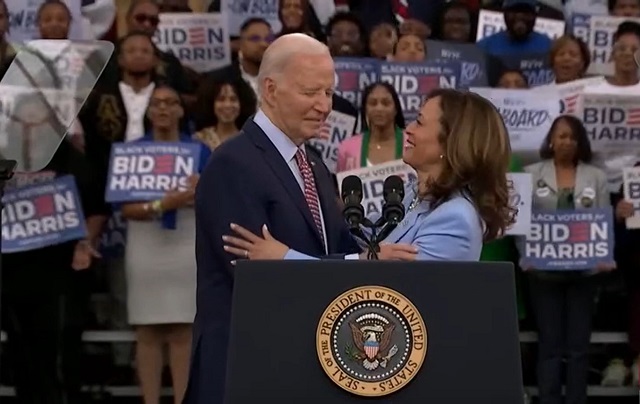Energy
8 ways the Biden / Harris government made gasoline prices higher

From Energy Talking Points
| By Alex Epstein |
Any politician who supports the “net zero” agenda is working to make gasoline prices much higher
This is Part 1 of a 4 part feature where I cover 4 of the top energy issues being discussed this summer
- Every politician will claim this summer that they’re working to make gasoline prices lower, because they know that’s what voters want to hear.
But the many politicians that support “net zero by 2050” are working to make gasoline prices higher.
- For the US to become anywhere near “net zero by 2050,” gasoline use needs to be virtually eliminated.¹
- Since Americans left to their own free will choose to use a lot of gasoline, the only way for “net zero” politicians to eliminate gasoline is to make it unaffordable or illegal.
Low gasoline prices are totally incompatible with “net zero.”
- The Biden-Harris administration knows that all fossil fuels, including gasoline, need to be far more expensive for them to pursue “net zero.” That’s why the EPA set a rising “social cost of carbon” starting at $190/ton—the equivalent of adding $1.50 a gallon to gasoline prices!²
- From Day 1, President Biden has openly supported the destruction of the fossil fuel industry, from his 2019 campaign promise of “I guarantee you, we’re going to end fossil fuel” to his 2021 executive order declaring that America will be “net zero emissions economy-wide” by 2050.³
- Kamala Harris has, unfortunately, been even more supportive of the “net zero” agenda and therefore higher gasoline prices. In 2020 she supported a fracking ban, which would have destroyed 60% of US oil production. And she cosponsored the fossil fuel-destroying Green New Deal.⁴
- Of course, Joe Biden and Kamala Harris, like all politicians, claim to be for lower gasoline prices. But because their real priority is the “net zero” agenda, in practice they are doing everything they can to raise prices.
-
Here are 8 specific actions they’ve taken.
- Biden Gas Gouging Policy #1
Biden has worked to increase gasoline prices by taking a “whole-of-government” approach to reducing greenhouse gas emissions
. This entails reducing oil investment, production, refining, and transport, all of which serves to increase gas prices.⁵
- Biden Gas Gouging Policy #2
Biden has worked to increase gasoline prices by expanding the anti-fossil-fuel ESG divestment movement
. ESG contributed to a 50% decline in oil and gas exploration investments from 2011-2021, resulting in artificially higher prices. Biden is making it worse.The ESG movement is anti-energy, anti-development, and anti-America
·January 6, 2022ESG poses as a moral and financially savvy movement. In reality it is an immoral and financially ruinous movement that is destroying the free world’s ability to produce low-cost, reliable energy. This prevents poor countries from developing and threatens America’s security. Read full story - Biden Gas Gouging Policy #3
Biden has worked to increase gasoline prices via “climate disclosure rules,”
an oil and gas investment-slashing measure that coerces companies into spouting anti-fossil-fuel propaganda and committing to anti-fossil-fuel plans—plans that will raise gas prices.The “climate disclosure” fraud
·Mar 16Congress won’t support Biden’s anti-fossil-fuel agenda. Read full story
- Biden Gas Gouging Policy #4
Biden has worked to increase gasoline prices by issuing a moratorium on oil and gas leases on federal lands, stunting oil and gas production and investment
. When it’s harder to produce and invest in oil, gasoline gets more expensive.⁶
- Biden Gas Gouging Policy #5
Biden has worked to increase gasoline prices by hiking the royalty rate for new oil leases by 50%
. This is money the government gets from the industry on top of taxes. And it discourages oil investments, meaning less production meaning higher gas prices.⁷ - Biden Gas Gouging Policy #6
Biden has worked to increase gasoline prices by restricting oil and gas leasing on nearly 50% of Alaska’s vast petroleum reserve
. This is a crippling blow to Alaska’s oil and gas industry. Less Alaskan oil means higher gas prices.⁸ - Biden Gas Gouging Policy #7
Biden has worked to increase gasoline prices by threatening to stop oil and gas mergers
. Mergers, which increase efficiency, benefit domestic production and lower prices. Blocking mergers raises oil prices long-term, which means higher gas prices.Why government should leave oil and gas mergers alone
·Jun 3Myth: Oil and gas mergers are bad for America because they make oil more expensive. Read full story - Biden Gas Gouging Policy #8
Biden has worked to increase gasoline prices by cancelling the Keystone XL pipeline
. This prevented Canada from using its vast oil deposits to their full potential—meaning lower global supply and higher prices for oil and gasoline.⁹ - Joe Biden should level with the American people and make clear that his agenda is to increase gasoline prices—much like Obama’s infamous admission that “electricity rates would necessarily skyrocket” under his energy plan.
Or he should apologize and embrace energy freedom.¹⁰
“Energy Talking Points by Alex Epstein” is my free Substack newsletter designed to give as many people as possible access to concise, powerful, well-referenced talking points on the latest energy, environmental, and climate issues from a pro-human, pro-energy perspective.
Business
Climate Climbdown: Sacrificing the Canadian Economy for Net-Zero Goals Others Are Abandoning

By Gwyn Morgan
Canada has spent the past decade pursuing climate policies that promised environmental transformation but delivered economic decline. Ottawa’s fixation on net-zero targets – first under Justin Trudeau and now under Prime Minister Mark Carney – has meant staggering public expenditures, resource project cancellations and rising energy costs, all while failing to
reduce the country’s dependence on fossil fuels. Now, as key international actors reassess the net-zero doctrine, Canada stands increasingly alone in imposing heavy burdens for negligible gains.
The Trudeau government launched its agenda in 2015 by signing the Paris Climate Agreement aimed at limiting the forecast increase in global average temperature to 1.5°C by the end of the century. It followed the next year with the Pan-Canadian Framework on Clean Growth and Climate Change that imposed more than 50 measures on the economy, key among them a
carbon “pricing” regime – Liberal-speak for taxes on every Canadian citizen and industry. Then came the 2030 Emissions Reduction Plan, committing Canada to cut greenhouse gas emissions to 40 percent below 2005 levels by 2030, and to achieve net-zero by 2050. And then the “On-Farm Climate Action Fund,” the “Green and Inclusive Community Buildings Program” and the “Green Municipal Fund.”
It’s a staggering list of nation-impoverishing subsidies, taxes and restrictions, made worse by regulatory measures that hammered the energy industry. The Trudeau government cancelled the fully-permitted Northern Gateway pipeline, killing more than $1 billion in private investment and stranding hundreds of billions of dollars’ worth of crude oil in the ground. The
Energy East project collapsed after Ottawa declined to challenge Quebec’s political obstruction, cutting off a route that could have supplied Atlantic refineries and European markets. Natural gas developers fared no better: 11 of 12 proposed liquefied natural gas export terminals were abandoned amid federal regulatory delays and policy uncertainty. Only a single LNG project in Kitimat, B.C., survived.
None of this has had the desired effect. Between Trudeau’s election in 2015 and 2023, fossil fuels’ share of Canada’s energy supply actually increased from 75 to 77 percent. As for saving the world, or even making some contribution towards doing so, Canada contributes just 1.5 percent of global GHG emissions. If our emissions went to zero tomorrow, the emissions
growth from China and India would make that up in just a few weeks.
And this green fixation has been massively expensive. Two newly released studies by the Fraser Institute found that Ottawa and the four biggest provinces have either spent or foregone a mind-numbing $158 billion to create just 68,000 “clean” jobs – an eye-watering cost of over $2.3 million per job “created”. At that, the green economy’s share of GDP crept up only 0.3
percentage points.
The rest of the world is waking up to this folly. A decade after the Paris Agreement, over 81 percent of the world’s energy still comes from fossil fuels. Environmental statistician and author Bjorn Lomborg points out that achieving global net-zero by 2050 would require removing the equivalent of the combined emissions of China and the United States in each of the next five
years. “This puts us in the realm of science fiction,” he wrote recently.
In July, the U.S. Department of Energy released a major assessment assembled by a team of highly credible climate scientists which asserted that “CO 2 -induced warming appears to be less damaging economically than commonly believed,” and that aggressive mitigation policies might be “more detrimental than beneficial.” The report found no evidence of rising frequency or severity of hurricanes, floods, droughts or tornadoes in U.S. historical data, while noting that U.S. emissions reductions would have “undetectably small impacts” on global temperatures in any case.
U.S. Energy Secretary Chris Wright welcomed the findings, noting that improving living standards depends on reliable, affordable energy. The same day, the Environmental Protection Agency proposed rescinding the 2009 “endangerment finding” that had designated CO₂ and other GHGs as “pollutants.” It had led to sweeping restrictions on oil and gas development and fuelled policies that the current administration estimates cost the U.S. economy at least US$1 trillion in lost growth.
Even long-time climate alarmists are backtracking. Ted Nordhaus, a prominent American critic, recently acknowledged that the dire global warming scenarios used by the Intergovernmental Panel on Climate Change rely on implausible combinations of rapid population growth, strong economic expansion and stagnant technology. Economic growth typically reduces population increases and accelerates technological improvement, he pointed out, meaning emissions trends will likely be lower than predicted. Even Bill Gates has tempered his outlook, writing that climate change will not be “cataclysmic,” and that although it will hurt the poor, “it will not be the only or even the biggest threat to their lives and welfare.” Poverty and disease pose far greater threats and resources, he wrote, should be focused where they can do the most good now.
Yet Ottawa remains unmoved. Prime Minister Carney’s latest budget raises industrial carbon taxes to as much as $170 per tonne by 2030, increasing the competitive disadvantage of Canadian industries in a time of weak productivity and declining investment. These taxes will not measurably alter global emissions, but they will deepen Canada’s economic malaise and
push production – and emissions – toward jurisdictions with more lax standards. As others retreat from net-zero delusions, Canada moves further offside global energy policy trends – extending our country’s sad decline.
The original, full-length version of this article was recently published in C2C Journal.
Gwyn Morgan is a retired business leader who has been a director of five global corporations.
Carbon Tax
Carney fails to undo Trudeau’s devastating energy policies

From the Fraser Institute
By Tegan Hill and Elmira Aliakbari
On the campaign trail and after he became prime minister, Mark Carney has repeatedly promised to make Canada an “energy superpower.” But, as evidenced by its first budget, the Carney government has simply reaffirmed the failed plans of the past decade and embraced the damaging energy policies of the Trudeau government.
First, consider the Trudeau government’s policy legacy. There’s Bill C-69 (the “no pipelines act”), the new electricity regulations (which aim to phase out natural gas as a power source starting this year), Bill C-48 (which bans large oil tankers off British Columbia’s northern coast and limit Canadian exports to international markets), the cap on emissions only from the oil and gas sector (even though greenhouse gas emissions have the same effect on the environment regardless of the source), stricter regulations for methane emissions (again, impacting the oil and gas sector), and numerous “net-zero” policies.
According to a recent analysis, fully implementing these measures under Trudeau government’s emissions reduction plan would result in 164,000 job losses and shrink Canada’s economic output by 6.2 per cent by the end of the decade compared to a scenario where we don’t have these policies in effect. For Canadian workers, this will mean losing $6,700 (annually, on average) by 2030.
Unfortunately, the Carney government’s budget offers no retreat from these damaging policies. While Carney scrapped the consumer carbon tax, he plans to “strengthen” the carbon tax on industrial emitters and the cost will be passed along to everyday Canadians—so the carbon tax will still cost you, it just won’t be visible.
There’s also been a lot of buzz over the possible removal of the oil and gas emissions cap. But to be clear, the budget reads: “Effective carbon markets, enhanced oil and gas methane regulations, and the deployment at scale of technologies such as carbon capture and storage would create the circumstances whereby the oil and gas emissions cap would no longer be required as it would have marginal value in reducing emissions.” Put simply, the cap remains in place, and based on the budget, the government has no real plans to remove it.
Again, the cap singles out one source (the oil and gas sector) of carbon emissions, even when reducing emissions in other sectors may come at a lower cost. For example, suppose it costs $100 to reduce a tonne of emissions from the oil and gas sector, but in another sector, it costs only $25 a tonne. Why force emissions reductions in a single sector that may come at a higher cost? An emission is an emission regardless of were it comes from. Moreover, like all these policies, the cap will likely shrink the Canadian economy. According to a 2024 Deloitte study, from 2030 to 2040, the cap will shrink the Canadian economy (measured by inflation-adjusted GDP) by $280 billion, and result in lower wages, job losses and a decline in tax revenue.
At the same time, the Carney government plans to continue to throw money at a range of “green” spending and tax initiatives. But since 2014, the combined spending and forgone revenue (due to tax credits, etc.) by Ottawa and provincial governments in Ontario, Quebec, British Columbia and Alberta totals at least $158 billion to promote the so-called “green economy.” Yet despite this massive spending, the green sector’s contribution to Canada’s economy has barely changed, from 3.1 per cent of Canada’s economic output in 2014 to 3.6 per cent in 2023.
In his first budget, Prime Minister Carney largely stuck to the Trudeau government playbook on energy and climate policy. Ottawa will continue to funnel taxpayer dollars to the “green economy” while restricting the oil and gas sector and hamstringing Canada’s economic potential. So much for becoming an energy superpower.
-

 Alberta1 day ago
Alberta1 day agoNational Crisis Approaching Due To The Carney Government’s Centrally Planned Green Economy
-

 Carbon Tax23 hours ago
Carbon Tax23 hours agoCarney fails to undo Trudeau’s devastating energy policies
-

 Business1 day ago
Business1 day agoThe UN Pushing Carbon Taxes, Punishing Prosperity, And Promoting Poverty
-

 Agriculture2 days ago
Agriculture2 days agoFederal cabinet calls for Canadian bank used primarily by white farmers to be more diverse
-

 Health22 hours ago
Health22 hours agoNEW STUDY: Infant Vaccine “Intensity” Strongly Predicts Autism Rates Worldwide
-

 Business21 hours ago
Business21 hours agoClimate Climbdown: Sacrificing the Canadian Economy for Net-Zero Goals Others Are Abandoning
-

 Great Reset1 day ago
Great Reset1 day agoCanadian government forcing doctors to promote euthanasia to patients: report
-

 Artificial Intelligence19 hours ago
Artificial Intelligence19 hours agoLawsuit Claims Google Secretly Used Gemini AI to Scan Private Gmail and Chat Data














